|
SAN PABLO gunboat
Not all San Pablo models
are of the same caliber.
Some out there are
seriously wrong.
They might
look good from afar but linger a bit more and you will
notice serious problems.
Those models' waterline is
ridiculous, which says a lot about the basic nautical
knowledge of the model's maker. Details and finish
are like that of a plastic toy. By the way, the color of
the real ship was light gray, not white. We
understand that all scale models have imperfection but
they don't have to suffer from grave errors like that.
That's structural; now the details: they lack so many
parts such as boxes, guns, bell. After you compare
our model with those,
you'll see that ModelShipMaster produces work of art, not
a
toy.
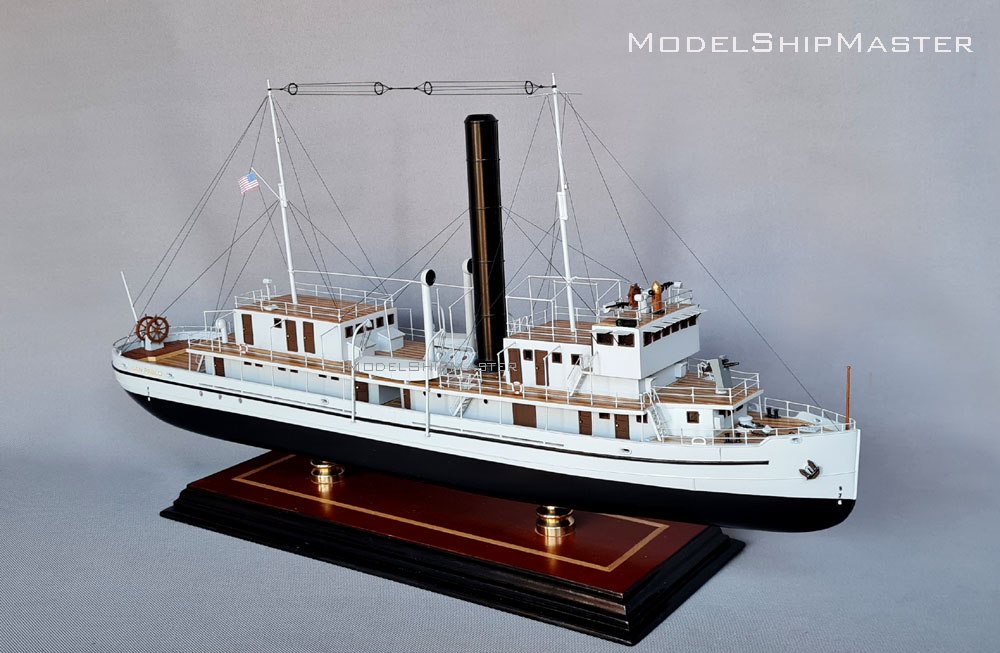
The USS
San Pablo was
featured in the 1966 film
"The Sand Pebbles." She
was a 150-foot steel-hulled gunboat, built by Vaughn &
Yung Engineering Ltd. of Hong Kong. A replica
of one type of U.S. navy gunboat used in China in the
1920's, the USS San Pablo was an ocean-going vessel
powered with a diesel engine, capable of ten knots. She
made the voyage by sea from Hong Kong to Taiwan and then
back to Hong Kong. She had such a shallow draft (about 3
feet) that there was no deck below the main deck. Much
of this space was occupied by machinery and the diesel
power plant, otherwise depicted in film as the crew
quarters.
"The Sand
Pebbles" is based on an award winning novel by Richard
McKenna, a former China Hand who served on the Yangtze
Patrol in the 1930s, although the story is set a decade
earlier. The novel was published in 1962 and won the
Harper Prize for fiction, chosen over 544 other
competitors. It was republished in 2000 by the Naval
Institute Press, perhaps due in part to the title being
included in the CNO's (Chief of Naval Operations)
Professional Reading Program, listed as #9 on its
Recommended Reading List.
The biggest talent search ever staged by Hollywood was
in connection with “The Sand Pebbles.” A working steam
engine, weighing 41,280 pounds and of the 1926 vintage,
was finally found in Vancouver, British Columbia. It was
aboard a fifty-year old Norwegian whaler on its way to
the scrap-yard.
The San Pablo may be best described as a creative
abstraction of the actual prototype gunboats,
incorporating design elements from them. It is chiefly
the work of production designer Boris Leven, well known
for his contributions to blockbuster movies such as
"Giant" and "West Side Story", which was directed by
Robert Wise, who also helmed "Sand Pebbles." Of the San
Pablo's fictitious design Leven commented that his
objective was to both simplify and accentuate the
gunboat's appearance while staying true to its historic
roots and function.
The Sand Pablo was the most expensive movie prop built
at the time of the movie's production. She alone cost a quarter million dollars.
The gunboat was
permanently manned by a crew of six.
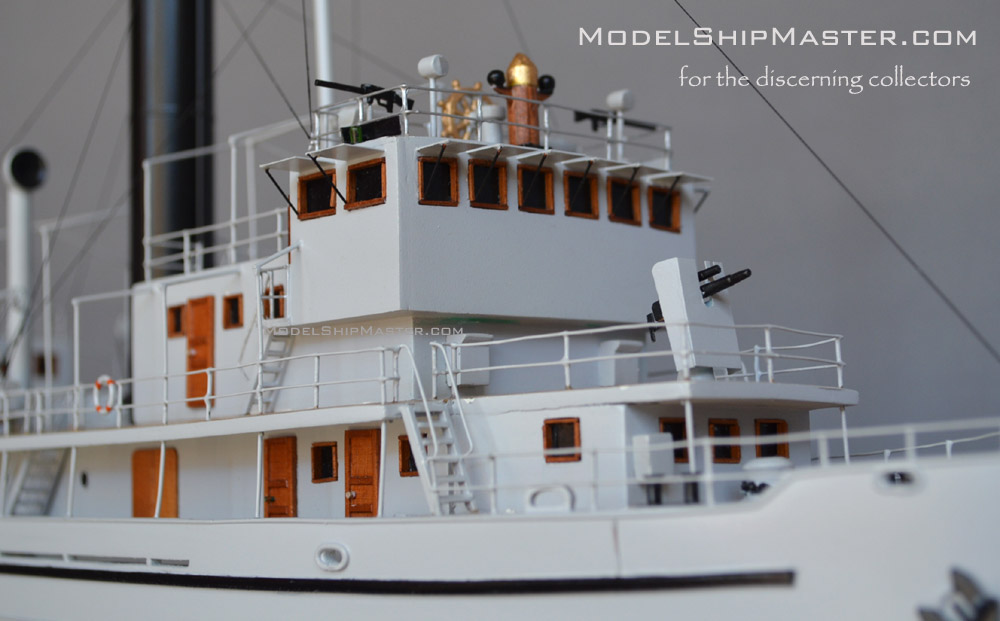
San Pablo
crossed the Formosan Straits in a storm and was overdue
by a day while an anxious company awaited her arrival.
In her period as a prime action prop, she ran aground
numerous times in the shallow Tam Sui River. In Hong
Kong waters, she was deliberately set afire. In total,
she was completely repainted eleven times during the
course of filming.
The “junk fight” at Sai Kung, wherein the
USS San Pablo is faced with a blockade, is one of the
most unusual sea battles ever staged. In the 1800’s and
through the early 1900’s, river pirates sometimes
blocked off waters with an array of junks bound together
by a heavy bamboo rope. The opposing forces in “The Sand
Pebbles” used this technique to blockade the gunboat.
The battle alone took two months of
preparation and the 1,000-foot bamboo rope which linked
the junks together weighed twenty-five tons. Battle
filming by the First Unit lasted a month in Sai Kung
waters. First Unit work was completed May 15, 1966.
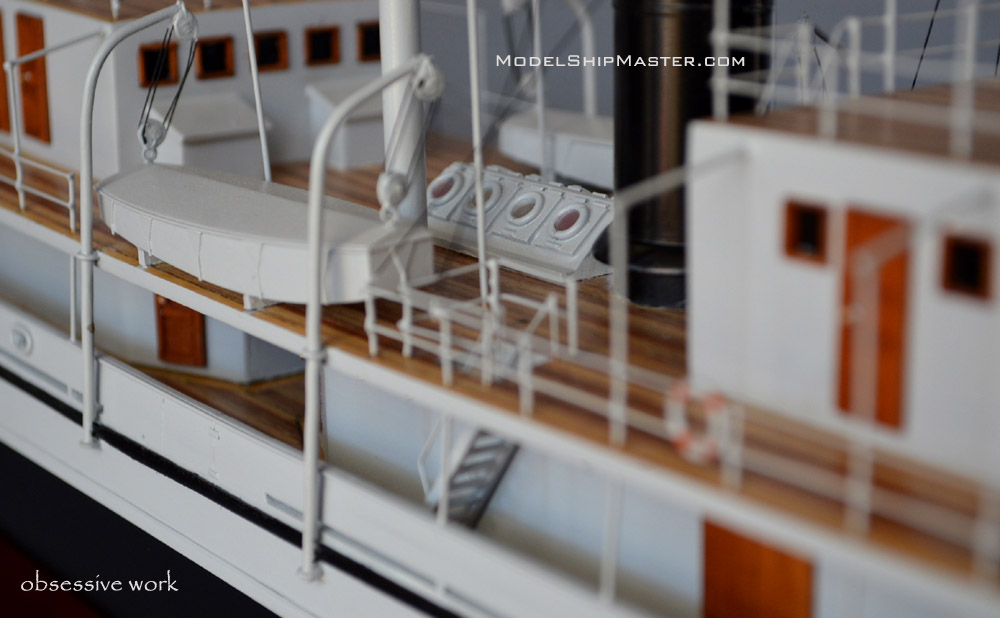
After the movie
San Pablo
was sold to the De Long Timber Co. in the Philippines.
It was renamed the “Nola D” after Nola Dianne Delong
the owner's wife or daughter. She was later sold to
Seiscom Delta Exploration Co. and used as a base camp in
Indonesia until the mid 1970’s. The Nola D was taken to Singapore and
broken up in 1975.
The
USS San Pablo was based on the USS Panay
(PG-45). And here
is a brief history of the USS Panay:
The United
States was not a participant in the mid-19th century
wars against China, but it was quick to take advantage
of China's undoing. The USS Susquehanna was the first
U.S. warship to steam up the mighty Yangtze River, in
1853; a motley collection of ships followed over the
years.
The first
"modern" U.S. warships arrived on the Yangtze only in
1903, when the USS Villalobos and USS Elcano arrived
from the Philippines. The ships were hot, dirty, and
poorly ventilated. They also were underpowered,
underarmed, and generally unsuitable for river duty; but
they patrolled the Yangtze for a quarter-century
nonetheless.
By the
turn of the century the China station was perhaps the
most sought-after assignment in the USS Navy. Americans
were above the law there, and most hedonistic pleasures
were readily and cheaply available. Thus there was a
need of increasing gunboats there.
In 1918, the Navy requested six gunboats. The Bureau of
Construction and Repair then agreed that the boats could
be built most economically in China.
The design
took detailed form during preparation of the 1924
ship-construction proposal. In October 1924, the Bureau
of Construction and Repair reported to Secretary of the
Navy Curtis D. Wilbur that the General Boards
recommended characteristics were being met, with some
alterations. These included reduced bulletproof
protection to meet weight limitation, diesel (instead of
steam) engines capable of driving the vessel at 15
knots, and three (as opposed to four) rudders. Not only
did these changes reduce the ships' maneuverability and
defensive protection, but Washington officials
overlooked the almost complete absence of diesel repair
facilities and personnel in China."
The bureau
by this time had produced a ship's plan based on the
Kiangnan design, resembling closely a typical
shallow-draft Yangtze River steamer. The Navy's
appropriations request for 1926 included $4.2 million to
build six such ships. Congress approved this request in
December 1924.
The ships
would be built in Shanghai, with the main propulsion
machinery (boilers, engines, and pumps), ordnance
equipment, bulletproof steel, and various other
"articles of outfit" furnished by the U.S. Government.
The United States ordered the first hull material on 12
March 1926. The shipbuilding contract allowed Kiangnan
12 months to build each gunboat, with the first, hull
number 43, scheduled for launching 1 November 1926 and
delivery to the Navy 1 March 1927.
The
gunboats were named officially on 10 May 1927: Guam
(PG-43), Tutuilla (PG-44) Panay (PG-45), Oahu (PG-46),
Luzon (PG-47), and Mindanao (PG-48) all Pacific Islands.
Construction delays resulting from material delays,
labor unrest, design changes, and Kiangnan's
inexperience resulted in the ships being delivered to
the Navy from 10.7 months (Guam) to 15.4 months (Tutuilla)
late.
The six
new gunships served on China's rivers throughout the
1930s, attempting to deal with the disruptive effects of
the fractionalized Nationalist government and its
struggles with the communists and the Japanese. The
ships protected merchant steamers, rescued U.S. and
other foreign citizens, and exerted a stabilizing
influence along China's waterways. Although U.S. naval
and diplomatic officers sought to carry out these tasks
without interfering in the country's internal affairs,
this was a forlorn hope, since the U.S. gunboats were
interfering in China simply by being there.
The squadron of six new
gunboats for the Yangtze Patrol was subdivided into
three pairs of different sizes, primarily in terms of
length and displacement, though similarly armed with two
3 inch guns for main armament and with equivalent
propulsion plants. The reason for the subgroups appears
to be their suitability for ease of navigation along
different segments of the Yangtze River, whose enormous
length – over 1,700 miles – presented challenges for the
larger sized boats, due to shallow water levels and
narrow spaces in the upper reaches during the dry
season, roughly from mid-October to mid-March, when the
level could drop to as low as 10 feet. It was not only
the matter of the need for hulls with shallow drafts,
but also of sufficient space for them to turn around in.
There also
areas of swiftly running currents, particularly in the
Three Gorges region where they could run as high as 14
knots, which meant the gunboats’ top speed of 15 knots
became highly problematic if no emergency power was
available and the need to traverse this length was
urgent.
| The smallest
pair of boats was Guam PG 43 and Tutuilla PG 44.
The Guam was launched first and appears to have
been fitted with a coal fired steam plant,
unlike the diesel engines that were specified
for the squadron. Its dimensions also closely
match those of the San Pablo prop boat used in
the movie, although the Guam had twin steam
plants, two propellers, a larger crew and was
more heavily armed. Its appearance, especially
from the bow, closely resembles that of the San
Pablo and clearly inspired the look of the movie
boat. |
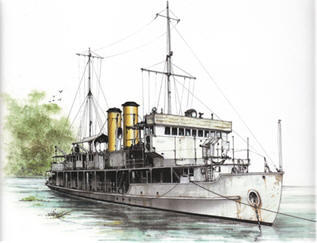
Artwork of Guam PG 43.
Length 159' 5"; Beam 27' 1”; Draft 5' 3"; Speed
14.5 kts; Complement 59; Armament: Two 3" gun
mounts and eight .30 cal. Lewis machine guns;
Propulsion: Two 950hp triple expansion steam
engines, two shafts. |
The war
with Japan claimed four of the gunboats. The Panay, sank
in December 1937, was the U.S. Navy's first World War II
casualty.
Japan's
1941 aggression marked the end of the U.S. gunboat
presence in China. The Japanese Navy destroyed the
Asiatic Fleet and the gunboats of the Yangtze Patrol met
varying fates. The U.S. Navy returned to China in 1945,
but the "unequal treaties" had been revoked and the
foreign presence drastically reduced. An era had ended
for the Navy with the loss of the gunboats in 1941. The
Asiatic Fleet and Yangtze Patrol existed thereafter only
in myth and legend.
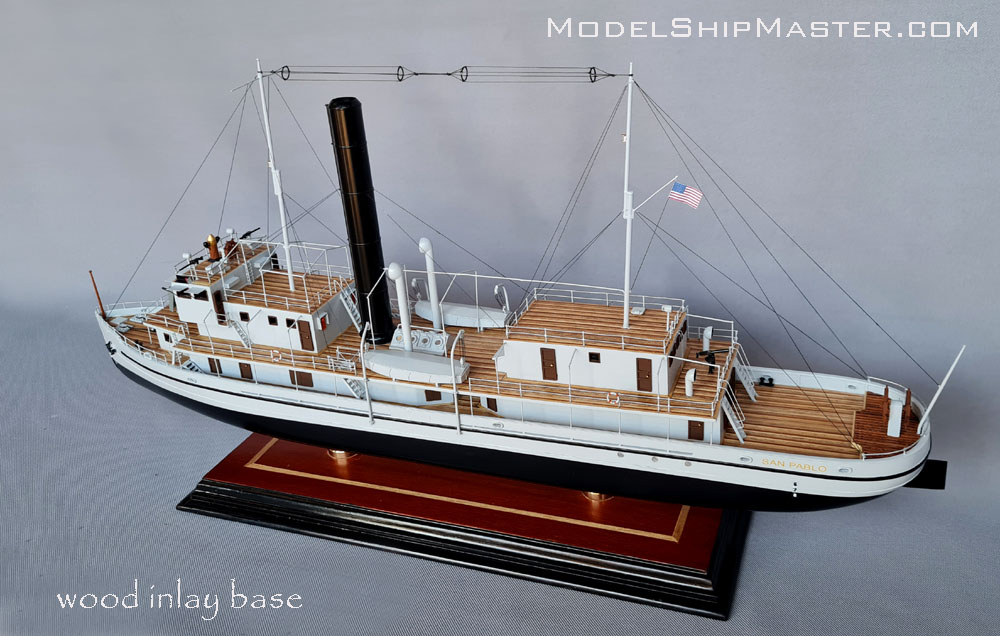
This primarily wood model
is
31" long x 11" tall x 6"
wide. $3,290
 shipping
and insurance in the USA included,
0ther
countries $300 flat rate. This model is in stock and can
be shipped within 5 business days.
shipping
and insurance in the USA included,
0ther
countries $300 flat rate. This model is in stock and can
be shipped within 5 business days.
24" long
x 9" tall x 5" wide. $2,790 shipping
and insurance in the USA included,
0ther
countries $250 flat rate.
This
model is built per commission only. We require only a
small deposit (not full amount, not even half) to start
the process $500  The
remaining balance won't be due until the model is
completed, in about 5 months. If you'd like to use with Paypal, let us know and we'll send you a bill. The
remaining balance won't be due until the model is
completed, in about 5 months. If you'd like to use with Paypal, let us know and we'll send you a bill.
Learn more about the
USS Panay here:
https://www.thesandpebbles.com/
Learn more about the USS
San Pablo here:
https://industrialhistoryhk.org/sand-pebbles/
For great details on
the historical background of The Sand Pebbles movie,
such as a map of the locations where many of incidents
in the film took place, including several ports, the
China Light Mission and the Battle of the Boom:
https://issuu.com/navalhistoricalfoundation/docs/nhf_flix_the_sand_pebbles
|